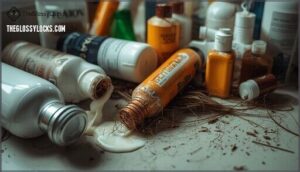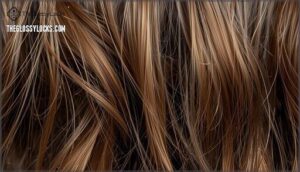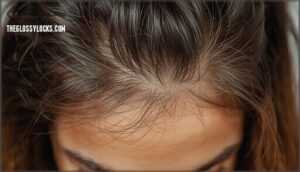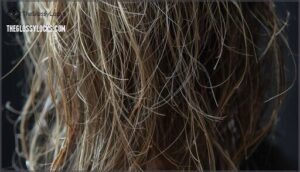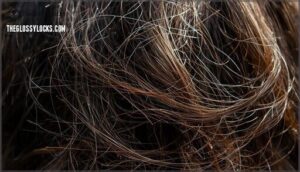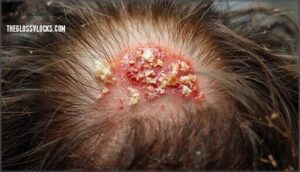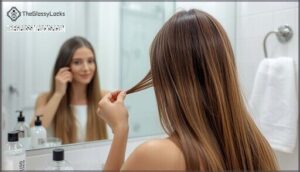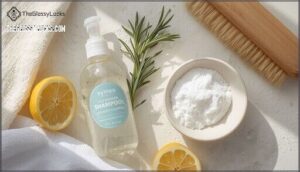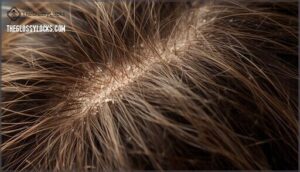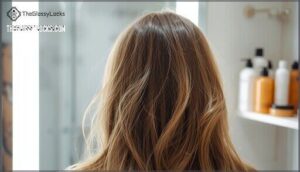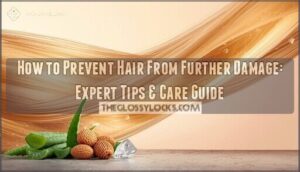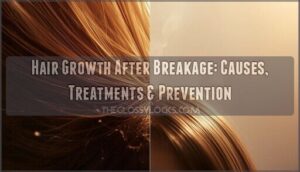This site is supported by our readers. We may earn a commission, at no cost to you, if you purchase through links.

Many common ingredients are designed to stick around, making it tricky to spot when buildup creeps in. Once you learn how to tell if your hair has product buildup, you’ll know the warning signs before they turn every wash day into a battle with your own scalp.
Table Of Contents
- Key Takeaways
- What is Hair Product Buildup?
- Why Does Product Buildup Happen?
- How Does Product Buildup Affect Hair?
- Signs Your Hair Has Product Buildup
- How Buildup Impacts Scalp Health
- Simple At-Home Tests for Buildup
- How to Remove Hair Product Buildup
- Best Practices to Prevent Buildup
- Can Product Buildup Cause Hair Loss?
- When to Adjust Your Hair Care Routine
- Frequently Asked Questions (FAQs)
- How do you know if your hair has product buildup?
- How do I know if my hair products are too much?
- How do you know if your hair is accumulating product?
- How do I know if I have product buildup?
- What does product buildup in hair look like?
- What causes build-up in hair?
- Is protein buildup permanent?
- How can I prevent protein buildup in the future?
- Are there any natural remedies to reduce protein buildup?
- How long does it take for hair to recover from protein overload?
- Conclusion
Key Takeaways
- Product buildup makes your hair look flat, greasy, and lifeless, even right after you wash it.
- Heavy ingredients like silicones, oils, and quats, plus infrequent or sloppy washing, are the biggest causes of stubborn residue.
- Signs of buildup include extra tangles, itchy scalp, sticky residue after scratching, and hair that’s dull or hard to style.
- The fix involves occasional clarifying shampoos, vinegar rinses, or clay masks—and staying on top of rinsing and routine cleansing prevents future buildup.
What is Hair Product Buildup?
Product buildup sneaks up on your hair, leaving it limp and lifeless before you know it. It’s usually the result of ingredients that love to stick around long after wash day.
Here’s what you should watch for as the main causes.
Common Ingredients Causing Buildup
Every bottle on your bathroom shelf has a story—especially regarding common hair product ingredients that linger long after the shine fades. Silicones, the main driver of silicone effects, coat your hair in a waterproof shield. Mineral oil and waxes create stubborn layers, leading to wax buildup and blocking moisture. Quaternary compounds—the “quats”—cling tightly to your strands, making that slippery, heavy feel hard to shake. Polymer residue from styling products is another stealth culprit.
When hair product ingredients stick around, they conspire to form relentless product buildup. Understanding the causes of hair product buildup is essential to preventing it.
How Buildup Accumulates Over Time
Buildup formation isn’t something you notice overnight. It sneaks up on you, stacking layer on layer until your hair feels unfamiliar. The longer you use styling products or rinse with hard water, the more product residue grips your strands. Week by week, you invite scalp irritation, a slower accumulation rate—or a rapid one if you’re heavy-handed—until your hair slumps under the weight.
Here’s what that looks like:
- Duller hair with each wash
- More frizz and tangles
- Scalp that starts to itch
- Heavier, limp strands
- Hair damage accumulating unseen.
Understanding scalp buildup causes is essential to addressing these issues.
Why Does Product Buildup Happen?
If you’re wondering why your hair keeps feeling weighed down, product buildup is often the culprit.
A few common habits and ingredients are usually to blame. Here’s what often leads to the problem.
Heavy Oils and Silicones
Silicones and heavy oils are the usual suspects behind stubborn hair product buildup. Oils like mineral oil cling to the strand’s surface, slowly layering into a visible hair film that traps dirt and weighs everything down.
Dimethicone and other silicones, a chemical interaction away from water, coat your hair so tightly they block moisture and nutrients. Over time, this residue builds—leaving you with flat, less responsive hair, scalp irritation, and a comb that just won’t glide.
Silicone effects don’t just gloss—they suffocate, making oil accumulation tough to budge without purposeful cleansing.
Infrequent or Ineffective Washing
It’s not just heavy silicones or oils weighing you down—wash frequency matters more than most people think. Infrequent or ineffective hair cleansing lets product residue, oils, and sweat cling to your scalp, tipping the scales on sebum regulation and disrupting scalp pH balance.
Go too long between shampoos, and you end up with layered buildup, especially if hair washing techniques aren’t thorough. Even the gentlest conditioner can start to feel like glue.
Clarifying shampoo steps in like a reset—knocking out stubborn layers your daily routine barely touches. Your hair’s porosity and shine depend on it.
How Does Product Buildup Affect Hair?
Product buildup doesn’t just sit on your hair—it changes how your hair looks and feels. If you’ve noticed a shift in shine, texture, or manageability, you might be dealing with more than just a bad hair day.
Here’s what to watch for regarding the ways product buildup can affect your strands.
Dullness and Lack of Shine
Ever run your fingers through your hair and wonder why that mirror-like shine has gone missing? Product buildup coats your strands, blocking moisture and scattering light unevenly—think fogged-up glass instead of crystal clear.
Dull hair is one of the first signs, as light reflection drops. Real shine restoration starts with clearing those film-forming residues and smoothing the cuticle.
Weighed-Down Strands
Gravity isn’t the culprit—product buildup drags your hair volume down, making every strand feel heavier and lifeless. Wonder why your hair resists a boost? Watch for these:
- Roots that can’t hold a style.
- Loss of fiber elasticity during humid days.
- Flattened cuticle lift after styling.
- Fine hair losing body despite your hair care routine or clarifying shampoo.
Breakage and Brittle Texture
Fragility creeps in silently—when product buildup blocks moisture, your hair’s natural defense breaks down. You’ll spot hair fracture and brittle ends well before full breakage sets in. Texture analysis often reveals uneven elasticity and weak spots. Look closely at breakage patterns and fiber weakness to catch the damage early.
| Symptom | What You Notice | Why It Happens |
|---|---|---|
| Brittle Ends | Dry, splitting tips | Loss of hair elasticity |
| Reduced Strength | Easy snapping | Accumulated residue |
| Texture Changes | Rough, uneven strands | Blocked cuticles |
| Weak Tension | Lacks bounce/stretch | Fiber weakness |
| Fragmented Fibers | Short, snapped pieces | Breakage patterns |
Signs Your Hair Has Product Buildup
If your hair’s not feeling its best, there’s a good chance product buildup could be behind it. The signs aren’t always obvious at first, but they can sneak up on you over time.
Here are a few clues to watch out for.
Greasy or Heavy Feeling
Notice your hair looking limp or roots feeling dense, even after washing? That greasy hair feeling is product buildup waving a red flag.
Oily scalp, heavy roots, and a sticky texture aren’t just annoyances—they signal product residue weighing strands down. If your hair care routine leaves you slick instead of refreshed, it’s time to rethink for better hair health.
Persistent Dryness Despite Conditioning
Your hair feels desert dry, no matter how much conditioner you pour on. That’s product buildup at work—residue forms a barrier, blocking moisture and starving strands of hydration.
Even with perfect moisture balance or low hair porosity, dry hair lingers until you focus on buildup removal. Product buildup is a top culprit behind stubborn dryness that simply refuses to quit.
Flat or Limp Appearance
Ever wonder why your hair flops, no matter how you style it? Product buildup acts like a heavy blanket, smothering root lift and adding strand weight.
When your hair lacks volume and looks dull, that’s the telltale sign—a stubborn product coating can reduce volume by up to 35%, leaving you fighting a styling response that just won’t come back.
Increased Frizz and Tangles
When strands lie flat thanks to heavy buildup, you’ll also spot a mess of frizzy tangles—especially as humidity amplifies the chaos.
Cuticle disruption from ingredient residue, like silicone or mineral oil, roughs up hair texture and increases the detangling force needed.
As a result, frizzy hair becomes stubbornly knotted, with styling a daily battle instead of a quick win.
How Buildup Impacts Scalp Health
When buildup starts stacking up on your scalp, it’s not just your hair that takes a hit. Your scalp can react in ways that are hard to ignore. Here’s what usually happens when product residue overstays its welcome.
Itching and Irritation
Why does your scalp suddenly feel like it’s crawling with ants? Scalp irritation often means residue accumulation from product buildup is disrupting your scalp microbiome and throwing your pH balance off.
Allergic reactions to common hair care ingredients or washing frequency missteps can magnify the problem—leaving hair follicles angry, your scalp itchy, and your overall scalp health in rough waters.
Flakes or Dandruff-like Residue
So, after that itchy scalp leaves you second-guessing your routine, spotting white flakes glued to your roots is another red flag. Product buildup and stubborn residue can easily masquerade as dandruff, but these flakes are sticky, uniform, and cling to hair instead of falling away.
Effective flake identification and residue removal is your ticket to restoring scalp balance and healthy hair texture.
Scalp Odor
No one talks about it, but if your hair starts smelling stale or musty no matter how often you wash, product buildup may be trapping odor-producing microbes right at your roots.
Microbial overgrowth thrives in the mix of sebum and residue, causing scalp odor that regular shampoo can’t tame.
It’s your cue that scalp health and hygiene factors need some extra attention.
Simple At-Home Tests for Buildup
If you suspect product buildup but aren’t sure, a few easy tricks at home can help you spot it.
These quick tests use your senses and take just a minute or two.
Here’s how to check if buildup is sticking around in your hair and on your scalp.
The Scalp Scratch Test
Ever wondered if product buildup is lurking on your scalp? Try the scalp scratch test: gently drag a clean fingernail over dry skin. Notice a whitish, waxy film under your nail? That’s a red flag for residue differentiation.
While this is a useful product buildup test method, be aware—recent dry shampoo can give false positives, so monitoring buildup over time matters for scalp health.
Hair-Feel and Texture Check
How can you spot product buildup creeping into your hair routine? Run your fingers through your strands and really tune in—does your hair feel sticky, coated, or unusually stiff? That’s a classic residue sensation.
You might notice softness loss, stubborn tangles, or an oily sensation—even right after washing. Identifying product buildup often starts with a simple Hair-Feel and Texture Check for sudden manageability issues.
Water Absorption Test
For a science-backed approach to buildup identification, the water absorption test is your go-to move. Simply immerse a clean hair strand and watch what happens:
- Hair floats up top? Product buildup in hair is likely slowing water absorption.
- Quick sink? Cuticle’s wide open—sometimes due to damage.
- Buoyant for minutes? Diagnostic limitations abound, so always pair this with other test integration techniques for accuracy.
How to Remove Hair Product Buildup
When stubborn residue weighs your hair down, you need more than a quick rinse. There are a few tried-and-true methods that can clear away buildup and bring your hair back to life.
Here’s how you can reset your strands and scalp with solutions you can actually try at home.
Clarifying Shampoo Method
Think of clarifying shampoo as your hair’s reset button. Packed with higher surfactant concentrations and chelating agents, this formula excels at removing product buildup from both hair and scalp.
You’ll notice more volume and shine after use, but stick to the recommended usage frequency—every two to four weeks—to avoid dryness and safeguard scalp health.
It’s a growing trend for a reason.
Apple Cider Vinegar Rinse
If your hair feels lifeless, don’t rule out a natural fix like apple cider vinegar. Thanks to ACV’s composition—5% acetic acid—it dismantles product buildup by dissolving stubborn oils and residue. Use one or two tablespoons in a cup of water after shampooing for:
- Glossier strands
- Restored pH balance
- Microbial defense
- Noticeably lighter hair
Baking Soda Scrub
Ready to shake things up? A baking soda scrub cuts through product buildup like a scalpel, thanks to its high pH. Just mix a tablespoon with water, massage in briefly, and rinse well.
While the scrub’s effectiveness is real for quick resets, overuse can trigger scalp irritation. Consider baking soda a strong DIY remedy, not an everyday routine.
Bentonite Clay Treatments
If baking soda felt a bit harsh, bentonite clay might just be your scalp’s relief valve. This clay’s negative charge attracts sticky residues, yielding deep cleansing without stripping your natural moisture.
- Select pure bentonite clay—look for fine, soft texture.
- Mix following application guidelines: three parts liquid, one part clay.
- Spread evenly, wait 10–15 minutes.
- Rinse thoroughly for refreshed scalp health and noticeable detoxification effects.
Best Practices to Prevent Buildup
If you want your hair to feel lighter and look healthier, it pays to be proactive. Taking a few extra steps in your routine makes a big difference. Here’s what you can do to stay ahead of buildup.
Proper Hair Rinsing Techniques
Ever wonder why your hair still feels weighed down, even with a solid hair care routine? The secret often lies in thorough hair rinsing. Aim for lukewarm water—hotter temperatures strip moisture, while chilly rinses seal cuticles for shine.
Spend at least 45 to 90 seconds to clear away surfactants, using gentle finger motions to loosen residue. Don’t underestimate water quality: hard water leads to more product buildup and less elasticity.
Scalp Exfoliation and Routine Cleansing
Once you’ve mastered rinsing, don’t overlook scalp exfoliation and routine cleansing. Exfoliation benefits your scalp by lifting away dead skin, oils, and leftover product—think of it as a reset button for Microbiome Balance. Most folks see the best results using exfoliation techniques (like silicone brushes or hydroxy acid scrubs) every week or two, and keeping their hair cleansing routine steady.
The right Cleansing Frequency helps keep product buildup from hijacking your hair. Preventive Maintenance? That’s just making these habits part of your regular hair care routine, teamed with the occasional clarifying shampoo.
Can Product Buildup Cause Hair Loss?
Wondering if leftover gunk from your hair products could actually lead to hair loss? You’re not alone. Let’s break down the main ways buildup might mess with your hair’s health.
Disrupted Follicle Health
Think of product buildup as the silent adversary inside your hair care routine, slowly clogging the very doorways—your hair follicles—where healthy growth should start. When buildup blocks follicles, it sparks Follicle Inflammation and invites Microbiome Imbalance.
Product buildup quietly clogs hair follicles, sparking inflammation and disrupting the scalp’s natural balance where healthy growth begins
Add heightened Sebum Production and harsh Chemical Stressors to the mix, and you set the scene for serious Structural Damage.
Over time, these invisible disruptions chip away at your scalp health and the strength of your follicles, making the groundwork less reliable and increasing your risk of lasting damage.
Increased Hair Shedding
When product buildup clogs your hair follicles, you aren’t just left with dull hair—you’re also inviting increased hair shedding and the risk of hair loss. Follicle clogging sets off a chain reaction that includes microbial imbalance, oxidative stress, and scalp inflammation, each pushing your follicles closer to shedding.
These conditions starve follicles of oxygen and nutrients, making hair fibers loosen more easily. The good news: shedding reversibility is within reach. Clear away the buildup, restore balance, and you’ll often see signs of product buildup—and your excess shedding—start to fade.
When to Adjust Your Hair Care Routine
Recognizing when it’s time to tweak your hair care routine can feel tricky, especially with so many products available. Certain changes stand out as helpful checkpoints. Here’s what to keep an eye on next.
Monitoring Product Usage
Application frequency isn’t just a number—it’s your early warning sign in the fight against product buildup. Tracking usage patterns and practicing quantity awareness help you catch buildup risk before your hair waves a white flag. Make routine logging a habit and watch for these:
- Out-of-control shine turning to grease
- Roots losing lift
- Scalp feeling itchy or weighed down
- Products stacking up, not rinsing out
Rotating Cleansing Methods
When your usual hair washing routine starts feeling stale, weaving in different cleanser types—like clarifying shampoos, moisturizing washes, or scalp exfoliators—can make all the difference.
Hair cycling through rotation frequency prevents product buildup, but also preserves your scalp microbiome’s balance.
The measurable benefits? Stronger, shinier hair, better hydration, and a cleansing routine that truly works for you.
Seeking Professional Advice if Needed
If you’re wrestling with stubborn dandruff, itchy scalp, or hair breakage that just won’t quit, it’s time for a Dermatologist Consultation or Trichologist Expertise.
These specialists pinpoint underlying scalp conditions and tailor Professional Treatments.
Ingredient Avoidance and Ongoing Monitoring aren’t just buzzwords—they’re the backbone of long-term solutions for hair loss and chronic buildup.
Frequently Asked Questions (FAQs)
How do you know if your hair has product buildup?
Ever wondered why your hair suddenly feels heavier, dull, or less manageable? Noticing buildup is all about tuning into subtle changes: rougher texture, limp roots, stubborn frizz, or persistent residue that doesn’t budge despite regular washes.
How do I know if my hair products are too much?
If your hair feels heavy, greasy, or loses its bounce after washing, that’s a sign of product overuse.
Dial back your hair care routine, focus on gentle cleansing, and use clarifying shampoo for better scalp balance and buildup prevention.
How do you know if your hair is accumulating product?
Product accumulation sneaks up when strands feel slick, flat, or heavier than usual—think limp roots and stubborn frizz. If your scalp itches or you’re seeing residue after washing, those are classic signs of buildup detection and Hair Analysis.
How do I know if I have product buildup?
Imagine running your hands through strands that feel waxy, limp, or suddenly hard to style—these are classic signs and symptoms of product buildup in hair.
Watch for scalp symptoms, persistent product residue, and changes in hair texture.
What does product buildup in hair look like?
Flat, dull strands that feel heavy or greasy are telltale buildup signs, especially if your hair texture loses volume or springs back less.
Look for sticky product residue, persistent dryness, and scalp issues that worsen your hair’s appearance.
What causes build-up in hair?
They say “an ounce of prevention is worth a pound of cure.” Hair product buildup sneaks in when heavy oils, silicones, improper rinsing, infrequent washing, and stacked styling products combine—causing product accumulation, scalp conditions, and ultimately, dull or brittle strands.
Is protein buildup permanent?
No, protein buildup isn’t permanent. You can reverse it with Protein Reversal Methods like clarifying shampoos and gentle cleansing techniques.
Restoring protein balance aids Hair Damage Repair, boosts shine, and helps prevent hair breakage.
How can I prevent protein buildup in the future?
Preventing protein buildup is all about striking a protein balance for your hair type. Choose lightweight, protein-free products, practice gentle cleansing, use clarifying shampoo occasionally, and adjust your hair care routine to your porosity and moisture control needs.
Are there any natural remedies to reduce protein buildup?
Ever wonder if your hair could use a fresh start? Natural remedies like apple cider vinegar or bentonite clay masks gently help restore Protein Balance, offering a simple Hair Detox without chemicals—far gentler than daily clarifying shampoo use.
How long does it take for hair to recover from protein overload?
Recovery from Protein Overload depends on how damaged your hair is. With the right mix of clarifying shampoo, hydration, and patience, most see hair restoration, less breakage, and better moisture in 2–12 weeks, depending on damage repair needs.
Conclusion
They say “what you can’t see, can hurt you”—and in the hair care sphere, product buildup proves it daily. Knowing how to tell if your hair has product buildup transforms your routine from guesswork to mastery.
Every wash becomes a choice, not a chore. When your strands feel lighter and your scalp breathes easier, you’ll recognize liberation hiding in clarity.
Start listening, trust your touch, and your hair will show you what freedom really feels like.
- https://curlwarehouse.com/blogs/news/signs-of-product-buildup-do-you-have-it
- https://globalnews.ca/news/5132876/woman-drugstore-shampoo-build-up/
- https://www.healthline.com/health/scalp-build-up
- https://pmc.ncbi.nlm.nih.gov/articles/PMC6369642/
- https://www.revuze.it/blog/consumer-priorities-shaping-hair-care/

